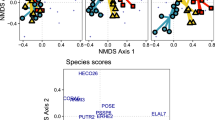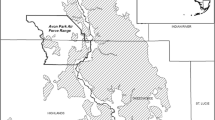Abstract
Postburn vegetation in an Artemisia tripartita and A. tridentata sagebrush community one year after the burn was compared with unburned vegetation. While the vegetal cover amounted to 38.1% of the total area on the burned site, it was 91.1% on the unburned site. Dominance-diversity curves for plant communities on both sites approach the niche pre-emption hypothesis or geometric series. Cover values and soil residual propagule data were used to suggest mechanisms of persistence of the more prominent species through fire using Noble & Slatyer's (1980) Vital Attributes model. The first year postfire vegetation was dominated by forbs and grasses with vegetative and propagule storage mechanisms of persistence. Such information on succession mechanisms should be of benefit to range managers.
Similar content being viewed by others
References
Binkely, G. S. 1980. Is succession in hardwood forests a stationary Markov process? For. Sci. 26: 566–570.
Clements, F. E. 1916. Plant succession. Publ. 242, Carnegie Inst. Wash. Washington.
Drury, W. H. & Nisbet, I. C. T. 1973. Succession. J. Arnold Arbor. 54: 331–368.
Floyd, D. A. & Anderson, J. E. 1982. A new point interception frame for estimating cover of vegetation. Vegetatio 50: 185–186.
Gleason, H. A. 1917. The structure and development of plant association. Bull. Torrey Bot. Club 44: 463–481.
Gleason, H. A. 1926. The individualistic concept of the plant association. Bull. Torrey Bot. Club 53: 7–26.
Hironaka, M. & Tisdale, E. W. 1963. Secondary succession in annual vegetation in southern Idaho. Ecology 44: 810–812.
Horn, H. S. 1975. Forest succession. Sci. Amer. 232: 90–98.
Humphrey, D. L. 1984. Patterns and mechanisms of plant succession after fire on Artemisia grass sites in southeastern Idaho. Vegetatio 57: 91–101.
Hurlbert, S. H. 1971. The nonconcept of species diversity: A critique and alternative parameters. Ecology 52: 577–586.
Kelsey, R. G., Stevenson, T. T., Scholl, J. P., Watson, T. J. & Shafizadeh, F. 1978. The chemical composition of the litter and soil in a community of Artemisia tridentata spp. vaseyana. Biochem. Syst. Ecol. 6: 193–200.
Kessell, S. R. & Potter, M. W. 1980. A quantitative succession model for nine Montana forest communities. Environ. Manage. 4: 227–240.
McIntosh, R. D. 1980. The relationship between succession and the recovery process in ecosystems. In: Cairns Jr, J. (ed.). The recovery process in damaged ecosystems. Ann Arbor Science Publishers, Ann Arbor, MI.
Moomaw, J. C. 1957. Some effects of grazing and fire on vegetation in the Columbia Basin Region, Washington. Diss. Abstr. 17: 733.
Noble, I. R. & Slatyer, R. D. 1980. The use of vital attributes to predict successional changes in plant communities subject to recurrent disturbances. Vegetatio 43: 5–21.
Pielou, E. C. 1969. An introduction to mathematical ecology. Wiley, New York.
Shannon, C. E. & Weaver, W. 1963. The mathematical theory of communication. Univ. Illinois Press, Urbana.
Simpson, E. H. 1949. Measurement of diversity. Nature 163: 688.
Van Dorp, D., Boot, R. & Van der Maarel, E. 1984. Vegetation succession on the dunes near Oostvoorne, the Netherlands, since 1934, interpreted from air photographs and vegetation maps. Vegetatio 58: 123–136.
Whittaker, R. H. 1975. Communities and ecosystems. MacMillan Publishing Co., New York.
Wright, H. A. & Klemmedson, J. O. 1965. Effects of fire on bunchgrasses of the sagebrush grass region in southern Idaho. Ecology 46: 680–688.
Wright, H. A., Neunschwander, L. F. & Britton, C. M. 1979. The role and use of fire in sagebrush-grass and pinyon-juniper plant communities. A state-of-the-art review. USA For. Serv. Gen. Tech. Rep. Int. 58, Intermountain For. and Range Expt. St. Ogden, UT.
Author information
Authors and Affiliations
Rights and permissions
About this article
Cite this article
Akinsoji, A. Postfire vegetation dynamics in a sagebrush steppe in southeastern Idaho, USA. Vegetatio 78, 151–155 (1988). https://doi.org/10.1007/BF00033424
Accepted:
Issue Date:
DOI: https://doi.org/10.1007/BF00033424




